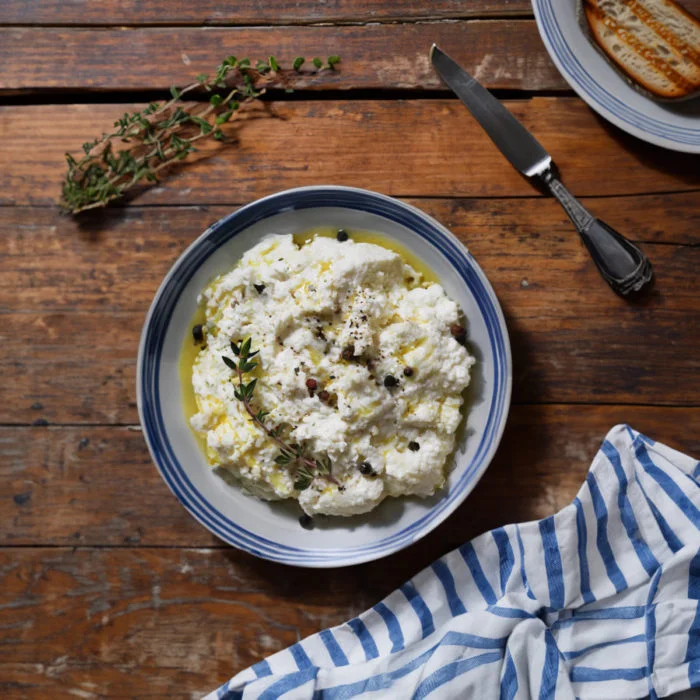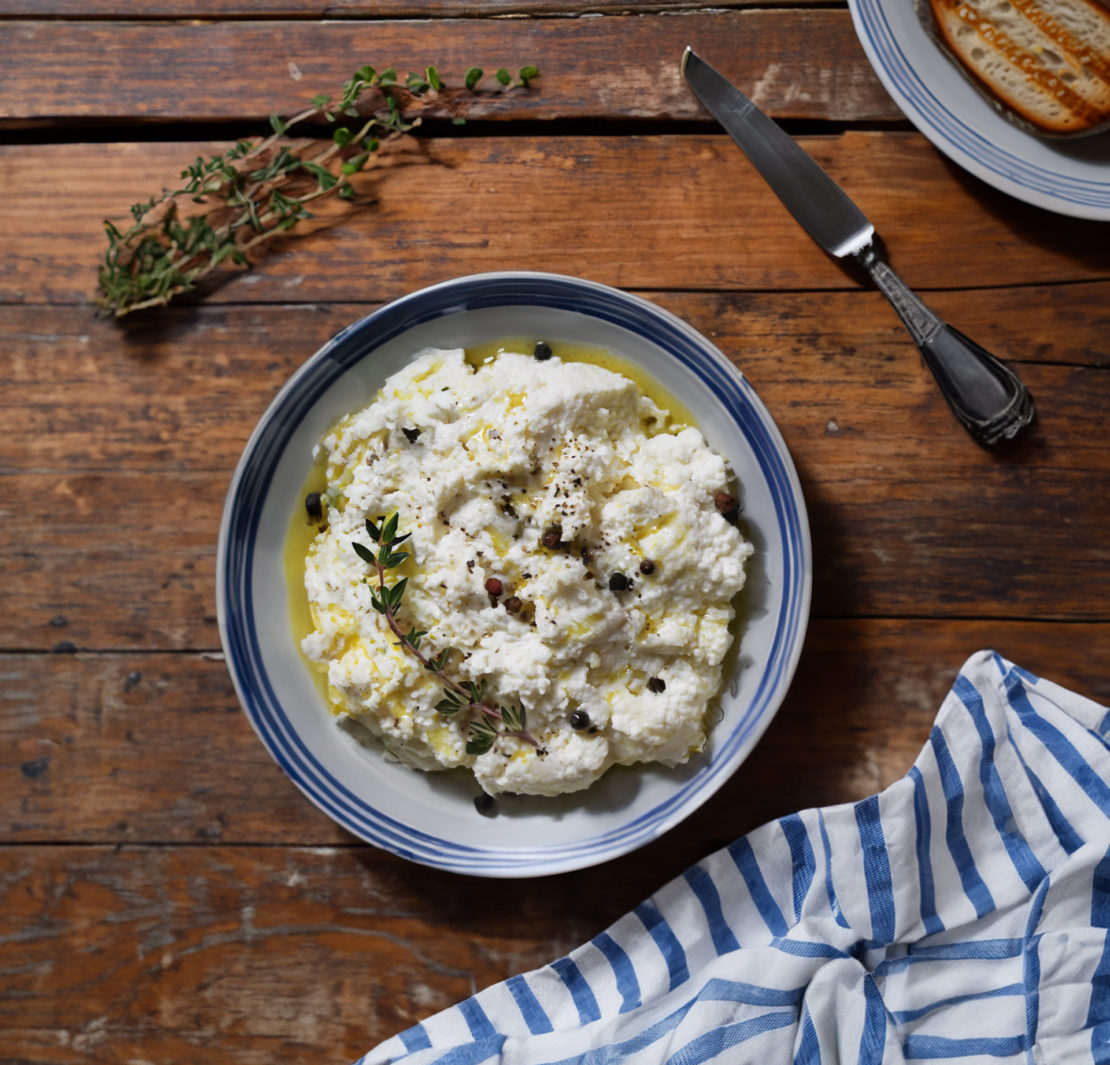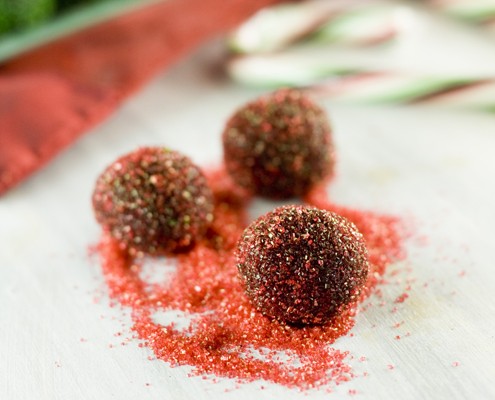Alexia Kannas is a writer and academic based in Melbourne,…
Fresh, rich and creamy: goat’s milk ricotta is the perfect accent for garlic-grilled breads, charcuterie boards and vibrant salads.
Living in Melbourne means that I have access to a good number of Greek cheeses; I can always buy Kaseri, Kefalograviera and, of course, feta. But what I really miss are the locally produced, soft, fresh cheeses that you buy by the scoop to spread on bread, or dollop into salads, or bake into pies. The most commonly known is mizithra, but there are different varieties made all over the country that use different combinations of cow, sheep and goat milk to achieve different levels of sharpness and a variety of textures. My favorite, xynomizithra, is a sour version of mizithra that tastes like a tangy incarnation of very fresh, rich ricotta. The best is thought to be produced on the island of Crete, where they use sheep and/or goat milk to make the cheese.
It’s going to be a little while before I can get back there to eat some, so I decided to make my own. I ate this first batch on grilled ciabatta, sprinkled with smoked sea salt, cracked black pepper and olive oil from the mother country – and it was almost as if I were back there in my grandmother’s kitchen on a warm summer morning, eating a little something at her insistence before heading to the beach. It was magic.
I’m thinking that the next lot (draining right now) might get folded into a filling for honey and cinnamon pastries, but I can’t wait to try this on pizza or as a filling for pasta. This is if I can get past the luxury of eating it on toast, perhaps topped with something sweet and sticky, like rose petal jam or a fresh fig. No matter how I decide to eat it, I feel I’ll be making this all summer long.

How to Make Goat’s Milk Ricotta Cheese
Ingredients:
- 1 liter (34 fl oz) fresh goat’s milk (unpasteurized is preferable, but pasteurized can also work)
- 1/2 teaspoon sea salt
- 3 tablespoons freshly squeezed lemon juice
Equipment:
- Nonreactive saucepan
- Wooden spoon or heat-resistant spatula
- Colander or fine mesh strainer
- Cheesecloth or butter muslin
- Large bowl
Step by Step Guide:
- Prepare Your Equipment: Before you begin, ensure that all your equipment is clean and ready to use. This helps prevent any unwanted bacteria from influencing the cheese-making process.
- Mix Milk and Salt: In a nonreactive saucepan, combine the goat’s milk and sea salt. Mix gently to dissolve the salt completely.
- Heat the Milk: Slowly heat the milk over low to medium heat. Stir occasionally to prevent the milk from scorching on the bottom of the pan. Use a cooking thermometer to monitor the temperature. The goal is to heat the milk to just before boiling, around 185°F – 200°F (85°C – 93°C). Do not let it boil as this can affect the formation of curds.
- Add Lemon Juice: Once the correct temperature is reached, remove the pan from heat. Gently stir in the lemon juice, then allow the mixture to sit undisturbed for 5 minutes. This will help the curds to form. If you do not see curds forming, let it sit for a few more minutes. The acidity and the temperature are crucial for curdling; if your milk is ultra-pasteurized, curdling might be difficult.
- Strain the Curds: Line a colander with a double layer of muslin or cheesecloth and place it over a large bowl. Gently pour the milk mixture into the colander, letting the whey drain away while the curds collect in the cloth.
- Let It Drain: Allow the curds to strain for at least an hour, or until the ricotta reaches your desired consistency. For a firmer ricotta, let it strain longer.
- Refrigerate and Store: Once strained, transfer the ricotta to a container. It can be refrigerated and used within 2-3 days. Pressing the ricotta under a weight in the fridge can further improve its texture, making it denser and more suitable for recipes requiring a firmer cheese.
Recipe Notes:
- Milk Quality: Fresh, unpasteurized milk works best, but if you only have access to pasteurized milk, try to avoid ultra-pasteurized varieties as they often do not curdle well. See notes further down on how to change the recipe if you need to use ultra-pasteurized milk.
- Acid Source: Lemon juice is preferred for its fresh flavor, but white vinegar can be used as an alternative. The amount might need adjustment based on the milk’s freshness and pasteurization.
- Temperature Control: Keeping the milk at the right temperature is crucial for successful curdling. If curds do not form, the milk may not have been warm enough, or the acid could have been added too early.
- Stirring: Minimal stirring after adding lemon juice is crucial as over-stirring can break the curds.
Notes on using Ultra-Pasteurized Goat’s Milk:
We definitely suggest that you use fresh, unpasteurized milk. However, we realize that not everyone has access to that. If you need to use ultra-pasteurized goat’s milk to make ricotta cheese, you often face the challenge of getting the milk to curdle due to the high-heat processing it undergoes, which changes the protein structure. However, there are a few adjustments and additional ingredients you can try to encourage curdling and improve your chances of making successful ricotta with ultra-pasteurized milk.
Note that these are not guarantees for success, but they will help:
Adjustments for Ultra-Pasteurized Goat’s Milk:
- Increase Acidity: Since ultra-pasteurized milk has a harder time curdling, increasing the amount of acid might help. If you’re using lemon juice, you may want to increase it by an additional tablespoon or two. Alternatively, white vinegar is a stronger acid and might be more effective. Start with 4 tablespoons of white vinegar instead of 3 tablespoons of lemon juice.
- Add Calcium Chloride: Calcium chloride can help restore the milk’s ability to form curds. It’s commonly used in cheesemaking with pasteurized and homogenized milks. Add about 1/4 teaspoon of calcium chloride dissolved in 1 tablespoon of water to the milk before you heat it. This can help the proteins in the ultra-pasteurized milk bond and form curds.
- Modify Heat Treatment: Heat the milk slowly and try not to exceed 185°F (85°C). Overheating can further denature the proteins, making curdling even more difficult. Use a thermometer to closely monitor the temperature.
- Extended Resting Time: After adding your acid, let the mixture sit undisturbed for up to 20 minutes instead of just 5 minutes. This extended resting period can give more time for slow-forming curds to develop.
- Use a Combination of Acids: Sometimes using both lemon juice and vinegar can help. The different properties of each acid can work together to better coagulate the proteins in ultra-pasteurized milk.
Final Notes on Using Ultra-Pasteurized Goat’s Milk:
If you end up using ultra-pasteurized goat’s milk, be prepared for varying results and consider the above adjustments. While these can improve your chances of making ricotta, the success rate might still be lower than with fresh or regular pasteurized milk. Always ensure that your acids are added only after the milk has reached the right temperature and that the milk is removed from heat immediately to prevent overheating.

Homemade goat’s milk ricotta
5 Stars 4 Stars 3 Stars 2 Stars 1 Star
4.9 from 24 reviews
- Author: Alexia Kannas
- Total Time: 1 hour 25 minutes
- Yield: 1-2 cups 1x
Description
This recipe will make between one to two cups of gorgeously creamy, fresh-tasting goat’s milk ricotta cheese.
Ingredients
- 1 liter (34 fl oz) fresh goat’s milk (unpasteurized is preferable, but pasteurized can also work)
- 1/2 teaspoon sea salt
- 3 tablespoons freshly squeezed lemon juice
Instructions
- Prepare Your Equipment: Before you begin, ensure that all your equipment is clean and ready to use. This helps prevent any unwanted bacteria from influencing the cheese-making process.
- Mix Milk and Salt: In a nonreactive saucepan, combine the goat’s milk and sea salt. Mix gently to dissolve the salt completely.
- Heat the Milk: Slowly heat the milk over low to medium heat. Stir occasionally to prevent the milk from scorching on the bottom of the pan. Use a cooking thermometer to monitor the temperature. The goal is to heat the milk to just before boiling, around 185°F – 200°F (85°C – 93°C). Do not let it boil as this can affect the formation of curds.
- Add Lemon Juice: Once the correct temperature is reached, remove the pan from heat. Gently stir in the lemon juice, then allow the mixture to sit undisturbed for 5 minutes. This will help the curds to form. If you do not see curds forming, let it sit for a few more minutes. The acidity and the temperature are crucial for curdling; if your milk is ultra-pasteurized, curdling might be difficult.
- Strain the Curds: Line a colander with a double layer of muslin or cheesecloth and place it over a large bowl. Gently pour the milk mixture into the colander, letting the whey drain away while the curds collect in the cloth.
- Let It Drain: Allow the curds to strain for at least an hour, or until the ricotta reaches your desired consistency. For a firmer ricotta, let it strain longer.
- Refrigerate and Store: Once strained, transfer the ricotta to a container. It can be refrigerated and used within 2-3 days. Pressing the ricotta under a weight in the fridge can further improve its texture, making it denser and more suitable for recipes requiring a firmer cheese.
Notes
- Milk Quality: Fresh, unpasteurized milk works best, but if you only have access to pasteurized milk, try to avoid ultra-pasteurized varieties as they often do not curdle well. See notes further down on how to change the recipe if you need to use ultra-pasteurized milk.
- Acid Source: Lemon juice is preferred for its fresh flavor, but white vinegar can be used as an alternative. The amount might need adjustment based on the milk’s freshness and pasteurization.
- Temperature Control: Keeping the milk at the right temperature is crucial for successful curdling. If curds do not form, the milk may not have been warm enough, or the acid could have been added too early.
- Stirring: Minimal stirring after adding lemon juice is crucial as over-stirring can break the curds.
Notes on using Ultra-Pasteurized Goat’s Milk:
We definitely suggest that you use fresh, unpasteurized milk. However, we realize that not everyone has access to that. If you need to use ultra-pasteurized goat’s milk to make ricotta cheese, you often face the challenge of getting the milk to curdle due to the high-heat processing it undergoes, which changes the protein structure. However, there are a few adjustments and additional ingredients you can try to encourage curdling and improve your chances of making successful ricotta with ultra-pasteurized milk. Note that these are not guarantees for success, but they will help:
Adjustments for Ultra-Pasteurized Goat’s Milk:
- Increase Acidity: Since ultra-pasteurized milk has a harder time curdling, increasing the amount of acid might help. If you’re using lemon juice, you may want to increase it by an additional tablespoon or two. Alternatively, white vinegar is a stronger acid and might be more effective. Start with 4 tablespoons of white vinegar instead of 3 tablespoons of lemon juice.
- Add Calcium Chloride: Calcium chloride can help restore the milk’s ability to form curds. It’s commonly used in cheesemaking with pasteurized and homogenized milks. Add about 1/4 teaspoon of calcium chloride dissolved in 1 tablespoon of water to the milk before you heat it. This can help the proteins in the ultra-pasteurized milk bond and form curds.
- Modify Heat Treatment: Heat the milk slowly and try not to exceed 185°F (85°C). Overheating can further denature the proteins, making curdling even more difficult. Use a thermometer to closely monitor the temperature.
- Extended Resting Time: After adding your acid, let the mixture sit undisturbed for up to 20 minutes instead of just 5 minutes. This extended resting period can give more time for slow-forming curds to develop.
- Use a Combination of Acids: Sometimes using both lemon juice and vinegar can help. The different properties of each acid can work together to better coagulate the proteins in ultra-pasteurized milk.
Final Notes on Using Ultra-Pasteurized Goat’s Milk:
If you end up using ultra-pasteurized goat’s milk, be prepared for varying results and consider the above adjustments. While these can improve your chances of making ricotta, the success rate might still be lower than with fresh or regular pasteurized milk. Always ensure that your acids are added only after the milk has reached the right temperature and that the milk is removed from heat immediately to prevent overheating.
- Prep Time: 15 mins
- Straining Time: 60 mins
- Cook Time: 10 mins
- Category: Side Dish
- Method: Curdling
- Cuisine: Greek
Alexia Kannas is a writer and academic based in Melbourne, Australia, who spends her days thinking and writing about cinema - and food. Fascinated by the relationship between food and memory, she writes about how cooking, meals and taste recall moments from film, literature, history and imagination. Her dream dinner-party guests are Jarvis Cocker and all her non-single friends. The two things she fears most are i) guests leaving hungry and, ii) a world without gin.





This looks amazing! I’ve made regular cow’s milk ricotta and loved it but never tried a goat version…I love goat cheese and this is so delicious.
Hey Sara. Thanks for your comment! Amazingly, my local supermarket has started carrying fresh goat milk in the regular dairy aisle, but before that I’d buy it at my fave health food store. It’s so worth it – trust me!
Alexia, thank you, this is brilliant. Can’t wait to try it…
Thanks, Megan! Let me know how you go.
I followed the recipe exactly but I didn’t get any cheese, just liquid. Help, what did I do wrong?
Hi Linda! What a bummer this is didn’t work out. Since I posted this recipe, I’ve made it 9 or 10 times and I did have it not work out once; the curds didn’t develop and it was just liquid, like you described. I’m guessing this is an issue with the temperature of milk, as it needs to reach a particular temperature to curdle. One of my sources said that this is the temperature just before boiling point, so I wing it and have nearly always had success. Maybe you could leave the milk on the burner a touch longer. Again, so sorry it didn’t work out on your first go – so disappointing. Do let me know if you try again and I will do so myself.
Thank you! I do have a thermometer and will try again. Looks and sounds so delicious.
I read with cow’s milk ricotta that it keeps for about three days in the fridge. Is that the case with goat milk ricotta, too?
Yeah, about 2-3 days in the fridge is correct.
I followed your recipe to the letter and I am currently enjoying a sandwich with the most delicious goat ricotta on it. Thank you!
At first I thought I’d done something wrong but it was just that the goat cheese has very fine curds. Cows milk has coarser curds but the cheese came out fine. I ended up just testing some of the liquid and found it was ready. I later saw another site where there was a sample of 3 types of milk and that was helpful too. Thanks for this great recipe.
Hello :)
Very happy to have found this site!
Can you please tell me if it matters which type of goat milk you use for this recipe in terms of fat content?
Thanks!
-Zosia
The tips on ultra-pasteurized milk are super important, because without them you will definitely not be able to make cheese. Thanks for a great recipe!
This is fabulous! We have goats, and this is fast and delicious- nice and lemony. Great with some fresh ground pepper too. I use a clean fine/flat tea towel to strain. Thank you!!
I have had a similar problem with very few curds forming. I used Meyer lemons and I think they are not acidic enough. I added some white vinegar boosted the temperature again and great curds resulted.
I hope this helps.
I ultrapasteurized goat’s milk, so got no curds initially. Tried again using the notes in the article, and it worked super well. Have some amazing cheese in the fridge now!
I don’t have any sea salt… how will using regular table salt affect my product? Looking forward to your answers. Many thanks.
Table salt can work, but most likely it has more chemicals in it than sea salt – so you may not get perfect results.
I too used Meyer lemons and when it didn’t curdle I added two tablespoons of white vinegar. It ended up with barely visible curds even after sitting in the pan for an hour. HOWEVER, it became a little thick so I just put in in a thin dishcloth inside a strainer. In two hours I had the creamiest goat’s ricotta imaginable. It was a cross between cream cheese and whipped cream.
Sliced some bread, brushed it with butter, broiled it for a few minutes. On top I put the ricotta and a little honey. It was fabulous!
Thanks for this lovely recipe! Used raw goats milk and it was perfect.
Cheers!
So I have twice tried making mozzerella on my own with goat cheese. Both times I ended up with ricotta. This recipe worked perfect the first time, so I am very happy!
This is absolutely next level delicious. We use a touch more salt, probably 3/4 tsp instead of 1/2 tsp. We are cow dairy free but can tolerate some goat milk and it is just so amazing to have cheese again. You must try this cheese in scalloped potatoes and just on crackers mixed with fresh herbs
“Got my goat” – It’s difficult to get goat milk around here, would powdered work ? want to make lasagna for those with cows milk allergy ? also same question for (mozzarella cheese)
This turned out perfect for me! Thanks for the notes on pasteurized milk!
No, powdered will not work with this specific recipe – but it’s not impossible to make cheese from powdered milk. It’s just a completely different process.
Hi Alexia just found you’re recipe for home made goats milk ricotta. I am lactose intolerant
So I can’t have cows milk. I am going to make lasagna but th recipe asks for ricotta cheese.
I find it impossible to buy the goats milk version of the cheese in supermarkets so I will use your recipe to make it my self. Many thanks for this recipe I think I can now make my version of lasagna.
Goat milk has lactose like cows milk. I think the reason we cannot tolerate bovine dairy is because if the A1 casein protein. Only A2 is found in goat sheep camel donkey and human milk, but not A1.
I finally got this to work with ultra-pasteurized milk, using the specific notes on it. Thank you!
Thanks. I just started using goats butter and look forward to more recipes…
I’ve done everything right, it seems, but I’m still waiting for curds. Maybe I didn’t let it sit undisturbed for long enough after adding the lemon juice and stirring. I assume if I leave it alone things will start happening. Fingers crossed!
It might be that your heating wasn’t on point, or that you over-stirred. Cheese making is a bit finicky, but hopefully it works out!
I’ve made this at least 6 times. It is delicious!!
I made this and only got half the volume of cheese claimed in the recipe. My milk actually just started to boil before I turned off the burner and I let it sit for more than ten minutes on the stove with the lemon juice before straining. I am wondering if letting it sit longer would’ve helped.
In any case, I have at least some ricotta for stuffing my pasta tonight, and it does taste amazing. Tangy enough that I don’t think I’d want to add more lemon juice.
How long will this keep when refrigerated?
Hi Niko, it keeps in the fridge for 2-3 days. Best to eat immediately!
This really turned out well for me, my first batch was not a huge success, but the second was perfect.
Haha, I just tried this and I’m shocked! It tastes awesome. I used 2% store bought pasteurized goat milk and used the juice of 1 large lemon. I found that for the heating it took me much longer like 20 minutes to reach 185F but maybe because it was my first time. But one litre yielded 200 grams of cheese. I used cheesecloth from a hardware store. I also did not use any salt (this is the main reason I wanted to try this). 30 grams of this will be my bedtime snack every night.
Just made this and it is AMAZING! Tasted just like we were in Greece in the summer. Used ultra pasteurized goat’s milk because that is all I could find. At first I thought it was not going to work, because I did not see any curds. I trusted the process, and it did work. The cheese did separate from the whey.
Just made this, and I have about a cup and a half of creamy, wonderful ricotta cheese.